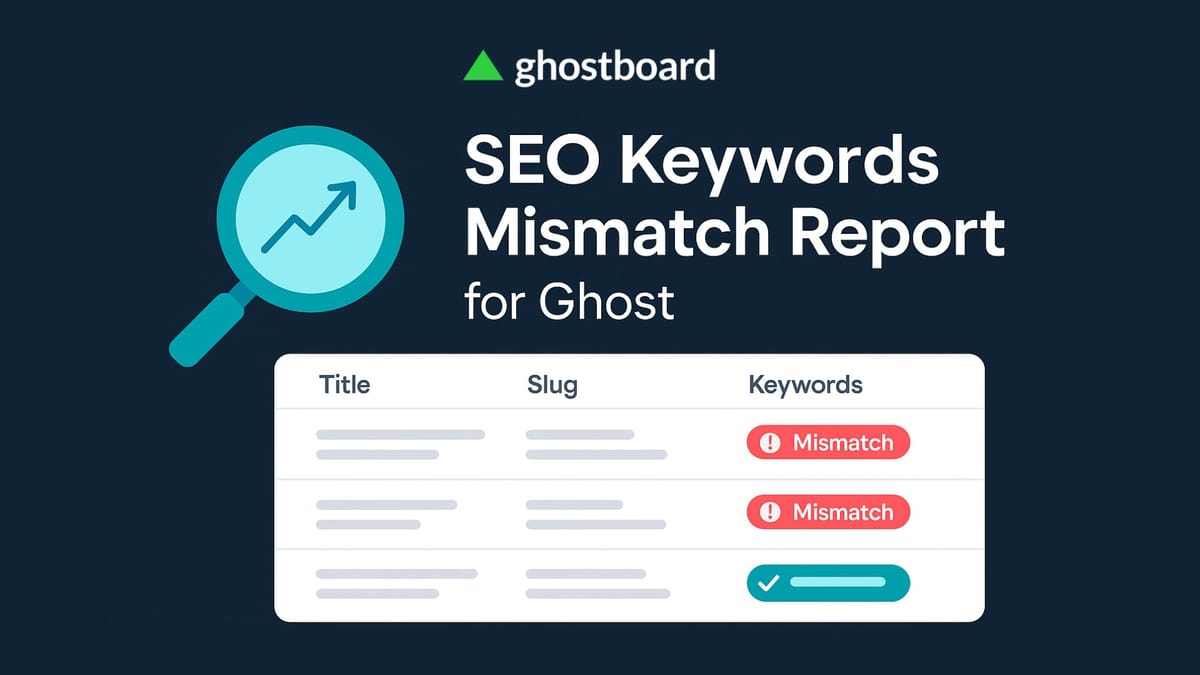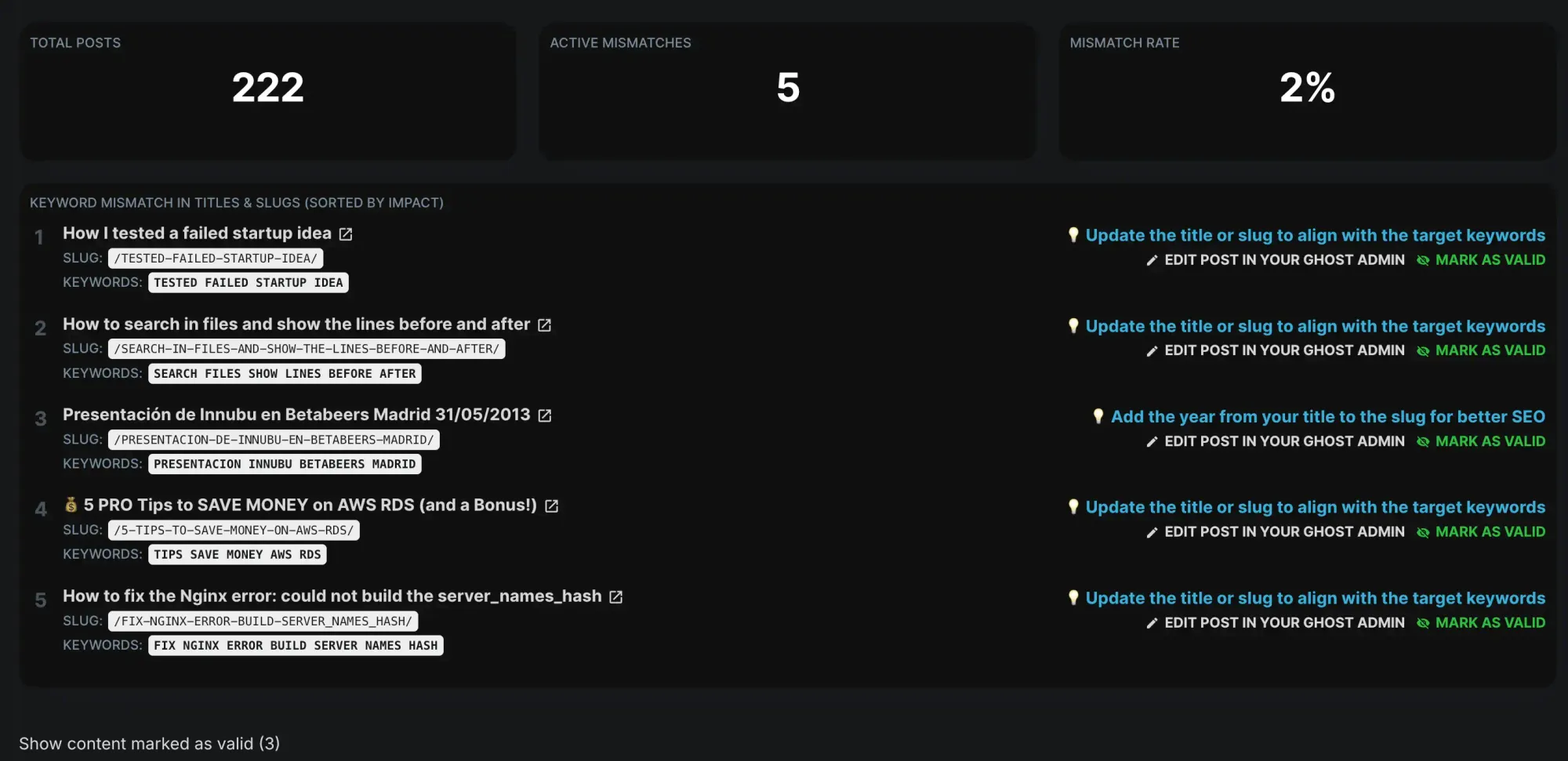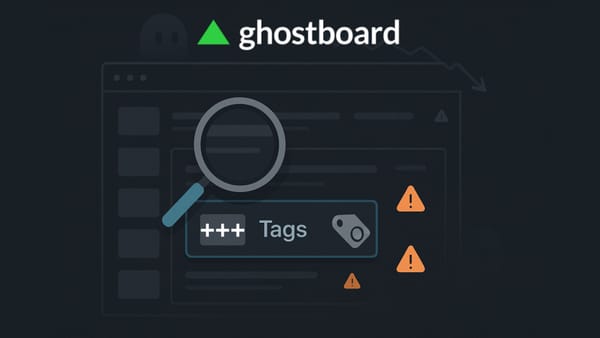New: SEO Keywords Mismatch Report for Ghost — Find & Fix Misaligned Posts in Seconds ✨
Learn more about the new SEO Keywords Mismatch Report in Ghostboard to spot and fix your Ghost blog SEO alignment in seconds

If you run a Ghost blog, SEO alignment is your secret weapon. Titles, slugs, and keywords need to point in the same direction. When they don’t, search engines get mixed signals. Rankings slip. Click-throughs drop. Growth slows.
That’s why we built the SEO Keywords Mismatch Report in Ghostboard. It spots posts where your title, slug, and keywords don’t match your intent. Then it guides you to fix them fast.
Below is a full walkthrough. Simple, actionable, and designed for busy creators. ⚡️
TL;DR
- Instant audit: See how many posts you have, how many are mismatched, and what % they represent.
- Clear list: Get each post with Title, Slug, and Keywords side by side.
- Smart tip: Read a quick recommendation to fix each mismatch.
- 1-click edit: Jump straight to the Ghost Admin edit screen for the post.
- Keep exceptions clean: Mark as valid when a “mismatch” is intentional, and it’ll be removed from the main list.
- Outcome: Cleaner metadata, sharper relevance, better rankings, higher CTR, and a smoother editorial workflow.

Why “keyword mismatch” hurts growth
Search engines look for consistency. When your page title says A, your slug says B, and your keywords say C, you dilute relevance. That can trigger:
- Lower topical relevance: Google struggles to pin down the main query you target.
- Weaker rankings: Competing pages with aligned signals win more often.
- Reduced CTR: If title and slug don’t match the promise, searchers hesitate.
- Cannibalization risk: Similar posts may target overlapping terms without a clear leader.
- Indexing friction: Mixed signals can delay or limit proper indexing.
Flip it around: aligned posts send a strong, unified signal.
You gain clarity, clicks, and momentum.
What the report shows (at a glance)
When you open the SEO Keywords Mismatch Report in Ghostboard, you’ll see:
- Total posts in your blog.
- Number of posts with keyword mismatch.
- Percentage of mismatched posts vs. your total.
Below that summary, a detailed list of affected posts including:
- Title (the headline your readers see)
- Slug (the URL path)
- Keywords (the terms you’re targeting for this post)
For each item, you also get:
- A recommendation to correct the mismatch.
- A direct link to edit the post in your Ghost Admin.
- An option to Mark as valid if the mismatch is intentional. Marked posts disappear from the main list to keep your focus sharp.
What counts as a “mismatch”?
A mismatch occurs when your title, slug, and keywords send different signals about the same post. A few common patterns:
- Title vs. slug drift:
- Title: “Best Coffee Beans for Cold Brew”
- Slug:
/best-espresso-beans - Keywords: “coffee beans, cold brew”
- Problem: The slug targets “espresso,” while the title and keywords target “cold brew.”
- Keyword vagueness vs. precise title:
- Title: “Ghost SEO Checklist for 2025”
- Slug:
/ghost-seo-checklist-2025 - Keywords: “blogging, marketing, tips”
- Problem: Keywords are too broad and don’t align with the main intent.
- Competing terms in one post:
- Title: “How to Start a Newsletter in Ghost”
- Slug:
/start-a-newsletter - Keywords: “ghost newsletter, start newsletter, email marketing platform”
- Problem: The keyword set blends brand + generic + platform terms without a clear focus.
How the report helps you fix issues fast
Think of this as a mini content-SEO cockpit:
- Scan the summary. See the size of the problem in seconds.
- Open the list. Review Title, Slug, and Keywords side by side.
- Read the recommendation. Get a quick suggestion for the best fix.
- Click “Edit in Ghost.” Jump straight to the post in Ghost Admin.
- Apply the fix:
- Align your title with the main keyword.
- Update the slug to echo that keyword in a short, readable way.
- Tune your keywords to match your primary target (and any supporting terms).
- Mark as valid if the mismatch is intentional (e.g., branded slugs, legacy links, campaign slugs). It leaves the main list to reduce noise.
Repeat. You’ll move through dozens of posts in minutes, not hours.
Example: from mismatch to momentum
Before
- Title: “Best Coffee Beans for Cold Brew (2025 Guide)”
- Slug:
/best-espresso-beans - Keywords: “best coffee beans, cold brew beans, cold brew coffee”
Issue
Slug conflicts with the main topic (“espresso” vs. “cold brew”).
Fix
- Title: “Best Coffee Beans for Cold Brew (2025 Guide)” ✅
- Slug:
/best-coffee-beans-for-cold-brew✅ - Keywords: “best coffee beans for cold brew, cold brew beans” ✅
You could also add the 2025 at the end of the slug if it makes sense.
Impact
- Stronger topical match across all signals.
- Clearer search intent.
- Higher odds of ranking and better CTR for the exact query you want.
When to “Mark as valid”
Not every mismatch is a mistake. In these cases, it can be strategic:
- Legacy URLs: You keep a short, memorable slug for brand reasons.
- Campaign landing pages: The slug matches a promo, while the title targets a keyword variant.
- Series or taxonomy quirks: You use a consistent slug pattern, but title/keywords vary by episode.
- Audience conventions: Your readers expect certain titles; you keep slugs cleaner for UX.
Use Mark as valid to remove these posts from the main list. The report stays focused on issues that truly need editing.
The benefits (and why they matter) ✨
1) Higher rankings for the right queries
Aligned signals boost topical relevance. That helps search engines trust your page for the terms you care about.
2) Better CTR from search
Matching title + slug + keywords means your snippet looks coherent. People click when the promise is clear.
3) Less cannibalization
Reduce overlap across similar posts. Each page gets its own lane and query focus.
4) Faster editorial workflow
The report gives you a clean queue. Recommendations tell you what to do. The Edit link gets you there in one click.
5) Cleaner content architecture
Consistent slugs and titles make internal linking, sitemaps, and analytics easier and more reliable.
6) Compounding gains
Small fixes at scale lead to bigger results. You tighten hundreds of signals across your site. Growth compounds.
Practical tips for fast, high-quality fixes 🔥
- Pick one primary keyword. Every post needs a single, clear target.
- Mirror it in the slug. Keep it short, descriptive, and human.
- Front-load the keyword in the title. But keep it natural and enticing.
- Support with 1–2 secondary terms. Add them to your keywords list if relevant.
- Avoid keyword stuffing. Clarity beats repetition.
- Keep redirects in mind. If you change a slug on a published post, set up the proper redirect so you don’t lose equity.
- Document your exceptions. If you mark a post as valid, add a quick note in your editorial docs so the team knows why.
Frequently asked questions
Does the report change my posts automatically?
No. It flags mismatches and gives you a recommendation. You make the final edits in Ghost Admin with one click from the report.
What does “keywords” mean here?
These are the target keywords you associate with the post for SEO. The report compares those against your title and slug to check alignment.
What if I like my quirky slugs?
No problem. Hit Mark as valid. Keep your style, remove noise from the list, and focus on posts that need edits.
Will fixing mismatches hurt existing rankings?
If you change a slug on an indexed post, set up the proper redirect. When done right, aligning signals helps rankings and CTR over time.
How often should I check the report?
A quick weekly pass works well for most teams. Add a monthly deep clean for bigger blogs.
Level up your Ghost blog 🚀
Start your free trial now and explore all Ghostboard features for free. No credit card is required.






